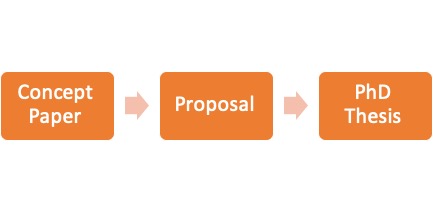A concept paper – or concept note – is one of the initial requirements of a PhD programme. It is normally written during the PhD application process as well as early on in the programme once a student has been admitted.
A concept paper is basically a shorter version of a research proposal – in most cases between 2,000 and 2,500 words – that expresses the research ideas of the potential PhD student.
Besides being short, it should be concise yet have adequate details to convince the Department the student is applying to that he/she is worth being admitted to the programme.
- Why Do PhD Programmes Require Applicants To Submit A Concept Paper?
- Format of a PhD Concept Paper
- Final Thoughts on Writing a PhD Concept Paper
Why Do PhD Programmes Require Applicants To Submit A Concept Paper?
A concept paper serves four main purposes:
- It gives the Department the student is applying to an idea of the student’s research interests.
- Based on point one, it informs the Department whether the student will be a good fit to the Department or not. To be a good fit, the research interests of the applicant should match those of the Department’s faculty.
- Based on the two points above, it enables the Department to offer support to the student throughout his/her PhD studies in the form of supervision and mentorship.
- Because the concept paper is written – and must be accepted – before the full proposal, it saves the student time and effort that would otherwise be spent on topics that may end up being rejected by the Department. A concept paper is therefore the first step to writing the PhD thesis/dissertation (see the figure below).

Format of a PhD Concept Paper
The format of a concept paper might vary from one university to another. A PhD student should therefore read the guidelines provided by his/her University of interest before writing a concept paper.
In general, the following is a common format of a concept paper:
Title of proposed study
The title of the proposed study is the first element of a concept paper.
The title should describe what the study is about by highlighting the variables of the study and the relationship between the variables if applicable.
The title should be short and specific: it is best to have a title that is not more than 15 words’ long.
Example of a title:
Use of Mobile Phone Applications for Weight Management in the United States
In order to add more specificity to the title, you can add a subtitle to the main title. The title and subtitle should be separated by a full colon.
Example of a title with a sub-title
Use of Mobile Phone Applications for Weight Management in the United States:
A Behavioural Economics’ Analysis
Background to the study
The background to the study contains the following elements:
- The history of the topic, both globally and in the proposed location of your study.
- What other researchers have found out from their own studies.
- What the gaps in the existing literature are, that is, what the other researchers have not addressed.
- What your study will contribute towards filling the identified gaps.
The implication of the above is that one must have conducted some literature review prior to writing the background to the study.
Statement of the problem
The statement of the problem is a clear description of the issue that the study will address, the relevance of the issue, the importance (benefits) of addressing the issue, and the method the researcher will use to address the issue.
Goal and objectives of the study
Once you have identified the problem of your study, the next step is to write the goal and objectives of the study. There is a difference between these two:
The goal of the study is a broad statement of what the researcher hopes to accomplish at the end of the study. The goal should also be related to the problem statement.
Any given project should have one goal because having many goals would lead to confusion. However, that one goal can have multiple elements in it, which would be accomplished through the project’s objectives.
The objectives of the study, on the other hand, are specific and detailed statements of how the researcher will go about accomplishing the stated goal.
The objectives should:
- Support the accomplishment of the goal.
- Follow a sequence, that is, like a step-by-step order. This will help you frame the activities needed to be undertaken in a logical manner so that the goal is achieved.
- Be stated using action verbs, for instance, “to identify”, “to create”, “to establish”, “to measure”, etc.
- Be about 3-4: having too few of objectives will limit the scope of your PhD dissertation, while having too many objectives may complicate the dissertation.
- Be SMART, that is, Specific, Measurable, Achievable, Realistic, and Time-bound.
The video below clearly explains how to set SMART goals and objectives:
https://www.youtube.com/watch?v=MAhs-m6cNzY
Important tip 1: depending on your PhD programme, you may be required to have at least 3 journal papers to qualify for graduation. Each of your objectives can be converted into a separate journal paper on its own.
Research questions and hypotheses
Every PhD dissertation needs research questions. Research questions will help the student stay focused on his/her research.
The aim of the research is to provide answers to the research questions. The answers to the questions will form the thesis statement.
Examples of research questions:
In the title example given earlier about use of mobile phone applications for weight management in the United States, a student may be interested in the following questions:
- To what extent do adults in the United States use mobile phone applications to manage their weight?
- Is there any gender disparity in the use of mobile phone apps for weight management in the United States?
- How effective are mobile apps for weight management in the United States?
Good research questions are those that can be explored deeply and widely as well as defended using evidence. Questions with ‘yes” or “no” responses are not academic-worthy.
When developing research questions, you also need to think about the data that will be required to answer the questions. Do you have access to that data? If no, will your time and financial resources allow you to collect that data?
Important tip 2: Your PhD study is time-limited therefore data requirement issues need to be thought through at the initial stages of your concept paper writing so that you don’t waste too much time either collecting the data in the future or trying to access the data if it already exists elsewhere.
Preliminary literature review
At the concept paper stage, a preliminary literature review serves three main purposes:
- It shows whether you have knowledge of the current state of debate about your chosen topic.
- It shows whether you are familiar with the experts in your chosen topic.
- It also helps you identify the research gaps.
Proposed research design, methods and procedures
This sections provides a brief overview of the research methodology that you will adopt in your study. Some issues to consider include:
- Will your study use quantitative, qualitative or mixed-methods approach?
- Will you use secondary or primary data?
- What will be the sources of your data? Will you need any ethical clearance from your university before collecting data?
- Will the data sources be readily accessible?
- Will you use external assistance for data collection? Or will you do all the data collection yourself?
- How will the data be analysed? Which softwares will you use? Are you competent in those softwares?
While the above issues are important to think through, please note that the research design and methods will be informed by your research objectives and research questions. As an illustration:
A research question that aims to measure the effect of one (or more) variable(s) on another variable will definitely require quantitative research methods.
On the other hand, a research question that aims to explain the existence of a phenomenon will render itself to the use of qualitative research methods.
Contribution to knowledge
This is perhaps the most important aspect of a PhD dissertation. Your concept note needs to briefly highlight how your project will add value to knowledge.
Making significant contribution to knowledge at the PhD level does not mean a Nobel prize standard of knowledge (this you can do after your PhD when you’ll have all the time in the world to do so). You can achieve this in various ways:
- New applications of existing ideas.
- New interpretations of previous ideas.
- Investigating an existing issue in a new location.
- Development of a new theory.
- Coming up with a new technique, among others.
References/bibliography
The last section of the concept paper is the reference list or bibliography. This is the section that lists the literatures that you have reviewed and cited in your paper.
There is a slight difference between a reference list and a bibliography:
A reference list includes all those studies that have been directly cited in the paper.
A bibliography, on the other hand, includes all those studies that have been directly cited in the paper as well as those that were reviewed and consulted but not cited in the paper.
When creating the reference list/bibliography, one should be mindful of the referencing style that is required by their PhD department (that is, whether APA, MLA, Chicago, Havard, etc).
Final Thoughts on Writing a PhD Concept Paper
The concept paper is the first step to writing the PhD dissertation. Once accepted, the student will proceed to writing the proposal, which will then be defended before proceeding with writing the full dissertation.
The concept paper is a mini-proposal and has most of the components expected in the proposal.
However, the concept paper should be short and precise while at the same time have adequate information to enable the PhD Committee of the PhD Programme the student is applying to judge if the student will be a good fit to the programme or not.
Related posts
How To Choose a Research Topic For Your PhD Thesis (7 Key Factors to Consider)
Comprehensive Guidelines for Writing a PhD Thesis Proposal (+ free checklist for PhD Students)

